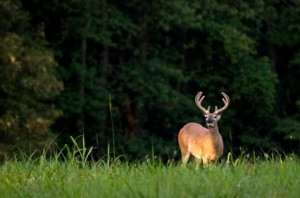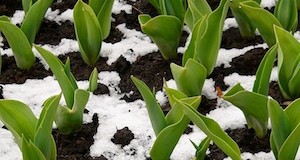 Do you have a piece of land you would like to attract more game animals to? Do you want to help that buck grow a really good rack? How about just making sure the wild game in your area have a source of nutrition when times are tough?
Do you have a piece of land you would like to attract more game animals to? Do you want to help that buck grow a really good rack? How about just making sure the wild game in your area have a source of nutrition when times are tough?
A wild game food plot can accomplish all that and more. Most people think of food plots for hunting whitetail deer, but they can feed, attract and support many other game animals.
Size and Location
Local conditions like climate, light, prevailing winds, and even the reason for the plot in the first place will dictate where you put your food plot.
If you are planting solely to provide nutrition for the animals, you can put your plot anywhere you like because the animals will find it, just like your garden. But if you plan to hunt near your plot, you will need to plan accordingly.
Ohio State University Extension Office recommends that you plant at least 1,000 square feet in your food plot. I feel this would hold true for plots of grasses and greens, but my experience with trying to grow small garden plots around my property shows that deer will come and feed repeatedly on even a small area of something they like.
When to Plant
Spring is the time to plant most plots, although some things like winter wheat, rye, and clover can be planted in the fall. Start your plot the same time as your garden, or as soon as the ground can be worked and the danger of frost is past. Just like your garden, they can be planted all the way up to late summer or early fall.
If you are serious, get a soil test done and add the proper amount of fertilizer to ensure a good stand. Make sure and work up a good seedbed just as you would do in your garden.
Deciding What to Plant
If you have limited funds and time, it might be best to just purchase a pre-blended commercial mix. These are formulated to make a wide range of food available over an extended period of time (usually an entire season). They usually include grasses, clovers, greens, and maybe some roots and grains. If you go this route, make sure and get a mix that is formulated for your area.
If you are like me, you might like to fiddle with things on your own, so you will want to come up with your own plan. Something to keep in mind is animals love the “big three” farm crops (corn, soybeans, and wheat). If you live in farming country with acres upon acres of these fields, planting a small plot of the same thing won’t draw too many critters to your place.
I live in the Midwest, where I am surrounded by fields of all three. I have noticed an exception in that animals seem to be drawn to the Indian corn I grow every year, but I think the key is that it is different, and critters like variety just like we do.
Grains
Winter Wheat – Wheat is usually one of the last green things available to graze in winter. The winter wheat fields around here are deer magnets late in the season.
Rye – Rye is grown the same as winter wheat.
Soybeans – Before they started using soy in everything, soybeans were raised as a hay crop. They were cut while green and leafy and cured for winter feed. Deer enjoy grazing them while they are still green.
Corn – I grow Indian corn that the deer like to munch when it is about six inches high. They then leave it alone until the ears start to dry, and then I have to watch out or I end up with ears eaten down about three quarters of their length.
Milo (Grain Sorghum) – I have not used this personally, but I do know the Ohio Division of Wildlife plants it on its own lands for a forage crop.
Sweet Sorghum – I grow this in my garden, and it gets up to ten or twelve feet tall—too tall for the grain to be browsed until late season weather knocks over the canes. The sweet canes provided late-season snacks for the few deer that discovered them last year.
Sunflowers – I tried about a quarter-acre field of oilseed sunflowers a couple years ago. I just bought a big bag at Wal-Mart and planted them with my single row planter. They came up and did very well, and I thought the deer were in for a treat until the birds showed up. Birds cleaned the field out in just a couple weeks. (Your results may vary.)
Buckwheat – As the name implies, deer love buckwheat. It is good for a green forage and grain. Buckwheat is frost tender, so it will be killed by the first cold snap.
Canola, Millet, and Others – Many other grains are used in lots of food plots. You can experiment to your heart’s desire.
Greens
Alfalfa – Alfalfa is the king of greens and high in protein. Alfalfa is a legume, and it will build your soil while it feeds your wildlife.
Clovers – There are several clovers available for planting. You should pick the one that is suited it your soil type. Clover is also a legume and, while not quite as potent as alfalfa, is still high in protein and nutrients.
Annual Chicory – Chicory is a green salad herb that is great for forage. This is not to be confused with perennial chicory, which it the weed you can use for homemade coffee.
Beans/Peas – Like soybeans, field beans and peas can be used for hay; thus, deer will use them for forage. I grew a plot of black-eye peas a few years ago and was very surprised at how much biomass it created in that small patch.
Roots
Root crops offer a real benefit when used for your food plot. They produce copious greens for summer foraging while storing food value in their roots that the deer will dig up and eat late in the season. This double shot is why root crops are a great choice for your plot.
Turnips – Even if you don’t like them, the deer do. They produce turnip greens in summer and turnips in fall and early winter.
Mangel/Stock Beets – These beets can grow to twenty pounds or more and will stay good in the ground through early/mid winter.
Daikon Radish – These are the same as other root crops: greens to start and then roots to finish.
Perennials
Apples – Deer love apple orchards. You can make like Johnny Appleseed and scatter apple seeds along the edges of your plot. In a couple years, the deer will be coming just to nibble on the young twigs.
Landscaping – You hear it quite often: ”The deer keep eating my XYZ bush.” If you find something the deer like in your landscaping, transplant some to your food plot area for them to munch on.
As a prepper, I figure the more wildlife I can attract to my place, the better off I will be if I need to rely on them for food some day. Establishing and maintaining a food plot can be just one more step in securing your future food supply.
©2012 Off the Grid News
 Off The Grid News Better Ideas For Off The Grid Living
Off The Grid News Better Ideas For Off The Grid Living




